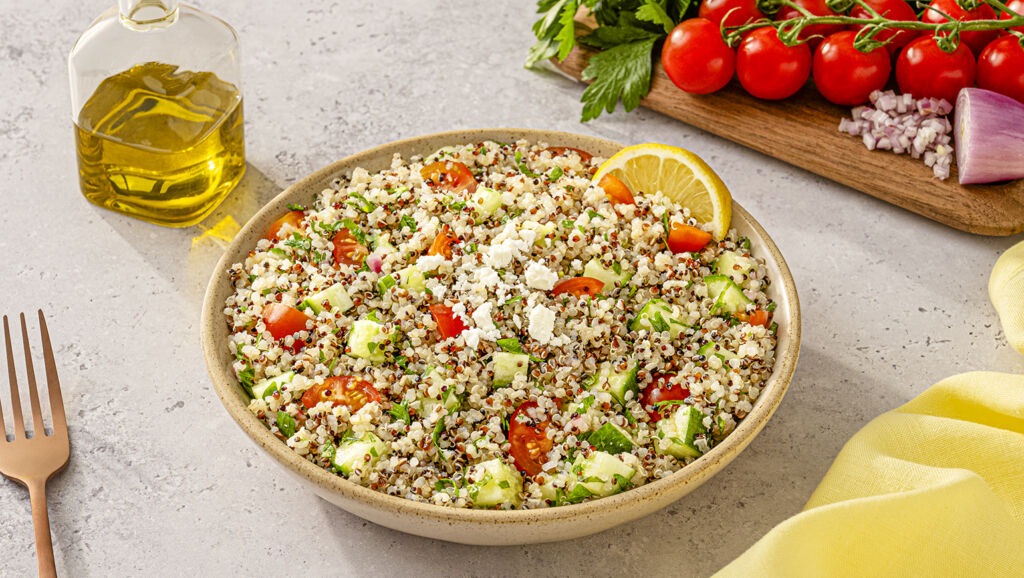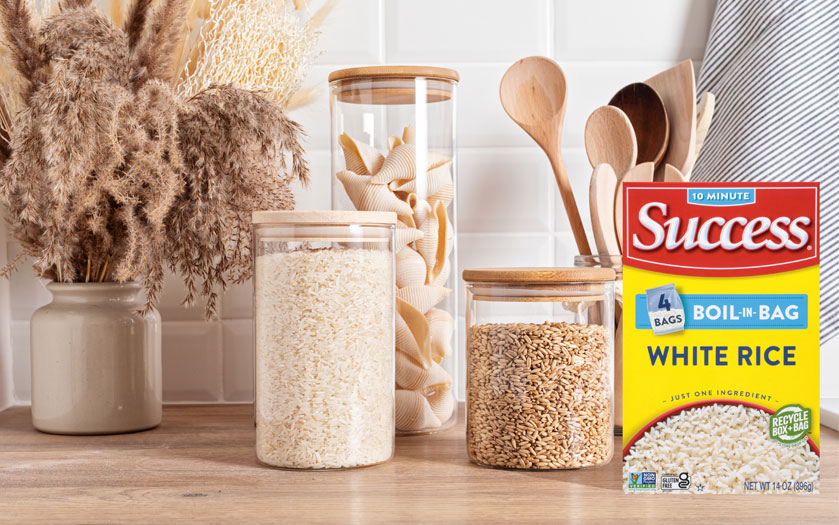Knowing how to store rice is key to minimizing waste, saving money and — best of all — enjoying delicious dinners, night after night! Whether you like to buy in bulk, and need to know how to store uncooked rice, or have a habit of cooking more than you can eat in one night, it’s important to learn how to store uncooked and cooked grains so that they stay as fresh as possible and ready to enjoy.
Why does proper storage matter? Protecting grains against humidity, air, pests and odors can extend their shelf life by preventing spoilage. This also helps to prevent waste, which is important for your bottom line. Correctly storing leftovers is crucial to maintaining their flavor and texture, but also to ensuring that they’re safe to enjoy at a later date.
Endlessly versatile and tasty, Success® Rice is an effortless addition to any meal. Thanks to its no measure, no mess packaging, it’s also simple for anyone to use — whether you’re a professional cook or are just getting comfortable in the kitchen. Make the most of every grain, by learning the best ways to store rice and quinoa today!
How to Store Uncooked Rice and Quinoa for Long-Term Storage
Workhorse ingredients that make regular appearances on the breakfast, lunch, dinner and dessert table, rice and quinoa are pantry staples we’re never caught without. If you hate running out of these ingredients, you may be in the habit of bulk-buying these popular grains. But do you know how to store grains long-term at home? Learn how to store rice and how to store quinoa with our favorite tips and tricks.
Choosing the Best Containers
To understand how to store grains long term at home, keep in mind that the key is to prevent light, air, odors, humidity and pests from reaching the grains. To do this, it’s important to transfer grains to airtight, food-grade containers that will prevent moisture and oxygen from seeping in. Whether you choose something as simple as a canning jar or prefer Mylar bags or sealable plastic containers, the key is to find a storage solution that will keep grains dry and odor-free.
What else should you keep in mind when learning how to store rice long term? Certain types of rice last longer than others. Due to the natural oils in the bran and germ layers of brown rice, it spoils faster than other types, such as white, jasmine or basmati. For this reason, most experts don’t recommend buying brown rice in bulk. Instead, try a handy option such as Success® boil-in-bag brown rice. Conveniently packaged for pantry storage, it’s just the right amount of rice to grab during your weekly grocery run.
Ideal Temperature and Location
Moisture, light and oxygen are detrimental to rice and quinoa, which is why any long-term storage solution should aim to minimize exposure to these environmental factors. Once you find the perfect container, it’s important to store rice and quinoa in a cool, dark spot, such as a pantry or cupboard. You can also refrigerate or freeze all types of rice and quinoa. Freezing is a great option for brown rice in particular, as it prevents the oils in the rice from going rancid.
How to Store Cooked Rice
Leftover cooked rice can be the start of your next great meal. Unless, that is, you don’t store it correctly. To avoid having to throw out leftover rice, follow these steps to learn how to store cooked rice.
Storing Cooked Rice in the Fridge
- When learning how to store rice after cooking, the first step is to cool the rice down as quickly as you can. Speed up the process by spreading the rice out onto a baking tray.
- Once the rice is at room temperature, refrigerate it in airtight containers in the fridge. You can use plastic, glass or silicone, but be sure to use containers with lids to prevent oxygen and fridge odors from damaging the grains. Remember, microwave-safe containers can save time when it comes to reheating your leftovers!
- For food safety, you should never leave rice at room temperature for long as it encourages dangerous bacteria to grow. Part of knowing how to safely store cooked rice is learning that you must always refrigerate rice within two hours of cooking.
- Eat leftover rice within four days, making sure to reheat it to a temperature of 165°F before tucking in. And don’t forget, leftovers make the best fried rice there is!

Freezing Cooked Rice
- To freeze leftover rice, follow the same steps as above but choose a freezer-safe container. For simple storage, you can also freeze rice in zip-top freezer bags.
- To avoid confusion, always label frozen rice. Include the date it was frozen and the type of rice on each label — once frozen, they can be hard to tell apart!
- For best results, use frozen rice within six months.
- To defrost frozen rice, place it in the refrigerator overnight. Alternatively, you can defrost frozen rice in the microwave or on the stove.
How to Store Cooked Quinoa
Knowing how to store cooked quinoa is the best way to save leftovers from ending up in the garbage. Turn leftovers into tomorrow’s loaded grain bowl, irresistible sweet treat, fresh salad or soup, all with a minimum amount of effort.
Storing Cooked Quinoa in the Fridge
- As with leftover rice, leaving quinoa at room temperature for longer than necessary can encourage harmful bacteria to grow. Cool freshly cooked quinoa as quickly as possible by dividing it between containers or spreading it out on a baking sheet. Once cooled, transfer leftover quinoa to an airtight container and store it in the fridge. Use leftover quinoa within seven days.
- Reheat leftover quinoa to a temperature of 165°F. Then, add to soups or desserts, or allow it to cool for use in salads or bowls. Never reheat leftovers more than once.

Freezing Cooked Quinoa
- Similarly to rice, cooked quinoa can be stored in the freezer to add to future meals. To do so, cool quinoa as quickly as possible after cooking. Divide the quinoa into individual servings or batches for the whole family in airtight, freezer-safe containers. Choose containers that seal shut, that can be stacked well, and that can be labeled with the date and description of what’s inside.
- Frozen quinoa should be used within six months. Always reheat leftover quinoa (in the microwave or over the stove) to a temperature of 165°F before enjoying.
Signs Your Rice or Quinoa Has Gone Bad
Despite your best efforts to safely store leftovers for future use, sometimes food has to be thrown out. If your rice has been in the fridge for more than four days, it’s best to throw it out. For quinoa, don’t wait more than seven days to consume refrigerated leftovers. Similarly, any rice or quinoa that’s been frozen for more than six months should be disposed of.
Despite the date on the calendar, if your leftover rice or quinoa looks slimy, discolored or moldy, or has a sour, musty smell, it’s probably off. Don’t take any chances and discard it ASAP!
Learning how to store rice and quinoa to use at a future date is a great first step toward a more sustainable kitchen. Whether you’re cutting back on food waste by stocking the freezer, batch cooking, then storing leftovers for a week of meals, or by keeping the focus on sustainable recipes, Success® Rice is the kitchen ally you need to help you reach your goals.

